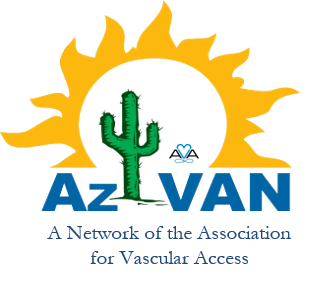AzVAN 2019 Annual Spring Conference:
When: Saturday March 23, 2019
Where: Mayo Clinic 13400 E. Shea Blvd Scottsdale, AZ 85259
Conference Agenda:
7:15 – 8:00 Registration and Breakfast
8:00 – 8:30 Opening Remarks
8:30 – 3:00 Conference
Cost:
$55.00 (Discounted Rate) for paid 2019 AzVAN Members
$65.00 for non-members
•Breakfast, Lunch, and Snack provided
(Payment is due in full at the time of registration)
Contact Hours:
•5.0 AzSRC CEU’s Pending Approval
•Provider pending approval by the California Board of Registered Nursing
Provider Number CEP12371 for 5 contact hours
Lectures/Speakers:
Catheter tip position: Why the Cavoatrial Junction- Vincent Tessitore MSRS, RTR, CT, VA-BC Clinical Education Manager, sponsored by Teleflex Objectives: 1. Define the cavoatrial junction(CAJ). 2. List three complications associated with catheter malposition. 3. Describe the clinical importanceof accurateand precise central catheter tip location. 4. Outline stepsto best practices for confirmationof central catheter tip location.
Tissue Adhesive: A New Tool for the Vascular Access Toolbox- Cora Vizcarra MBA, RN, CRNI, VA-BC Infusion Nurse Consultant sponsored by Adhezion BioMedical Objectives: 1. Review of Vascular Access device Complications. 2. Define the components and characterics of tissue adhesives. 3. Describe the purpose of tissue adhesives when used with VADs. 4. Analyze the clinical outcomes with tissue adhesives used with VADs.
Erasing the Taboo of the Femoral Central Line: Review and Case Studies of Mid-thigh Femoral Central Venous Catheters- Matt Ostroff, MSN, AGANCP, CRNI, VA-BC Pediatric and Adult Vascular Access Specialist, sponsored by 3M Objectives: 1. Define best practice. 2. Demonstrate understanding and respecting boundaries and limitations. 3. Describe the process in a teaching institution to implement a change in practice. 4. Inspire the audience to innovate, influence and further develop their vascular access programs.
18 year old professional patient! -Ansley McCormick, Sponsored by Mighty Well Objectives: 1. I would like the audience to understand ways they can best support their patients with vascular access needs, by learning about how I am supported as an individual facing chronic health challenges. 2. I want the audience to express what they think their patients need the most after seeing my slides and hearing my story. 3. I would like the audience to learn what life is like as a young adult on TPN and dependent of vascular access devices
Ultrasound for Vascular Access: #NoBlindSticks- Jack Ingold BSN, RN, VA-BC, Sponsored by Angiodynamics Objectives: 1.Identify the challenges associated with common vascular access procedures. 2. Define DIVA (difficult IV Access) patients. 3. Identify the challenges associated with the use of ultrasound. 4 Describe the steps for implementation of an ultrasound program.
